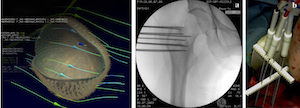We have investigated the transport of two types of nucleic acids (siRNA and DNA) in lipid vesicles using high voltage nanosecond electric pulses. First, we studied the elctrotransfer of siRNA in giant unilamellar vesicles (GUVs) and we report that a single ten nanosecond pulse can permeabilize lipidic vesicles for a couple of minutes and allow for the delivery of siRNA. Two mechanisms were found that may explain the field dependence of the siRNA uptake. Under high electric fields, siRNA can be directly funneled through large nanopores. Under intermediate fields, siRNA which are in strong interaction with the polar heads of the membrane phospholipids can slide electrophoretically along small nanopores and enter the vesicles. Then we studied the synergistic use of nanosecond electric pulses (NPs) and nanomolar doses of the recently-introduced CM18-Tat11 chimeric peptide. We quantitatively evaluated the cooperative effects of nanopulses and CM18-Tat11 on giant unilamellar vesicles (GUVs) and cells.. Our results confirm that nanopulses can induce transient pores on membranes but in this system, the peptide stabilizes membrane defects within endosomes. We have therefore demonstrated the potential of nanopulses as an efficient gene delivery system. Finally, to explain these results, we investigated at the molecular levels the effect of electric pulses on the membrane from a chemical point of view. Thanks to the use of GUVs, we have been able to investigate the chemical consequences of the application of pulses on membrane phospholipids and we are able to propose a new mechanism of the interaction of electric pulses with cell membranes.

|
|
|
|
Molecular mechanisms of the interaction of electric pulses with cells and cell models.
1 : Unité de Vectorologie et Thérapeutiques Anticancéreuses
(VTA)
CNRS : UMR8203
114 rue Edouard Vaillant 94805 Villejuif -
France
2 : Unité de Vectorologie et Thérapeutiques Anticancéreuses
(VTA)
Université Paris Sud - Paris XI
Orsay -
France
3 : Unité de Vectorologie et Thérapeutiques Anticancéreuses
(VTA)
Institut Gustave Roussy
114 rue Edouard Vaillant Villejuif -
France
|
 PDF version
PDF version
